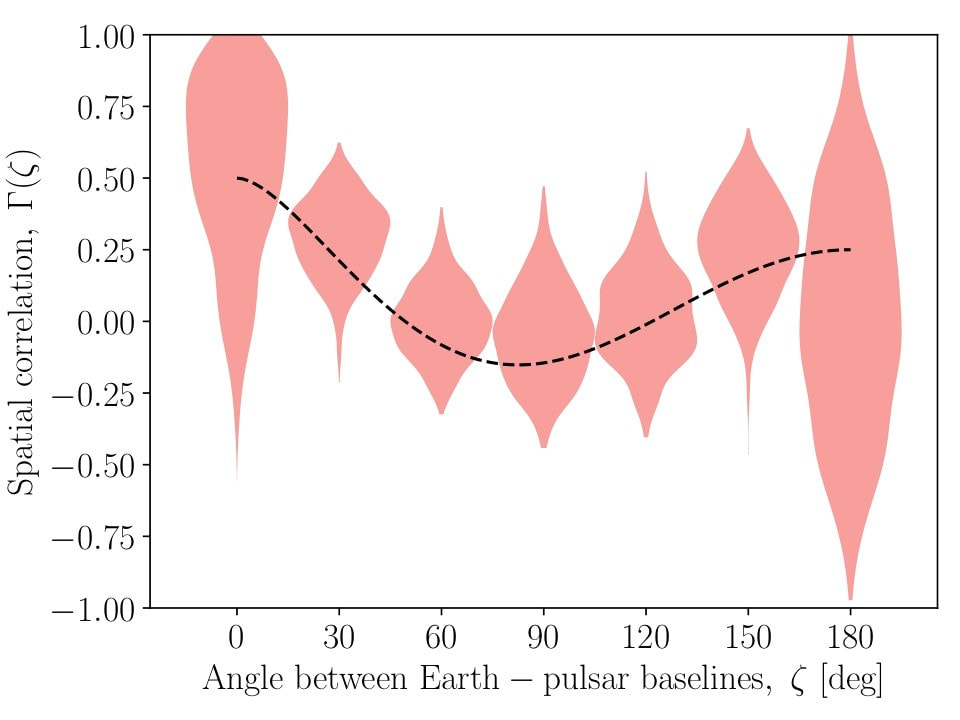|
Galaxies host supermassive black holes, which weigh millions to billions times more than our Sun. When galaxies collide, pairs of supermassive black holes at their centres also lie on the collision course. It may take millions of years before two black holes slam into each other. When the distance between them is small enough, the black hole binary starts to produce ripples in space-time, which are called gravitational waves. Gravitational waves were first observed in 2015, but they were detected from much smaller black holes, which weigh like tens times our Sun. Gravitational waves from supermassive black holes are still a mystery to scientists. Their discovery would be invaluable to figuring out how galaxies and stars form and evolve, and finding the origin of dark matter. A recent study led by Dr Boris Goncharov and Prof Ryan Shannon—both researchers from the ARC Centre of Excellence for Gravitational Wave Discovery (OzGrav)—has tried to solve this puzzle. Using the most recent data from the Australian experiment known as the Parkes Pulsar Timing Array, the team of scientists searched for these mystery gravitational waves from supermassive black holes. The experiment observed radio pulsars: extremely dense collapsed cores of massive supergiant stars (called neutron stars) that pulse out radio waves, like a lighthouse beam. The timing of these pulses is extremely precise, whereas the background of gravitational waves advances and delays pulse arrival times in a predicted pattern across the sky, by around the same amount in all pulsars. The researchers now found that arrival times of these radio waves do show deviations with similar properties as we expect from gravitational waves However, more data is needed to conclude whether radio wave arrival times are correlated in all pulsars across the sky, which is considered the “smoking gun”. Similar results have also been obtained by collaborations based in North America and Europe. These collaborations, along with groups based in India, China, and South Africa, are actively combining datasets under the International Pulsar Timing Array, to improve the sky coverage. This discovery is considered a precursor to the detection of gravitational waves from supermassive blackholes. However, Dr Goncharov and colleagues pointed out that the observed variations in the radio wave arrival times might also be due to ipulsar-intrinsic noise. Dr Goncharov said: “To find out if the observed "common" drift has a gravitational wave origin, or if the gravitational-wave signal is deeper in the noise, we must continue working with new data from a growing number of pulsar timing arrays across the world”.
0 Comments
Leave a Reply. |
|
- Home
- About
-
Our People
- Chief Investigators
- Partner Investigators
- Associate Investigators
- Postdocs and Students >
- Professional & Outreach staff
- Governance Advisory Committee
- Scientific Advisory Committee
- Executive Committee
- Equity & Diversity Committee
- Early Career Researcher Committee
- Professional Development Committee
- Research Translation Committee
- OzGrav Alumni
- Research Themes
- Education and Outreach
- Events
- News/Media
- Contact Us
- Home
- About
-
Our People
- Chief Investigators
- Partner Investigators
- Associate Investigators
- Postdocs and Students >
- Professional & Outreach staff
- Governance Advisory Committee
- Scientific Advisory Committee
- Executive Committee
- Equity & Diversity Committee
- Early Career Researcher Committee
- Professional Development Committee
- Research Translation Committee
- OzGrav Alumni
- Research Themes
- Education and Outreach
- Events
- News/Media
- Contact Us



 RSS Feed
RSS Feed








